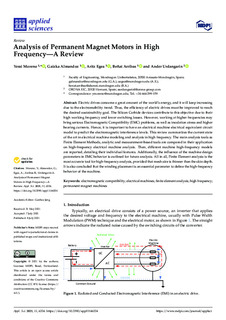| dc.rights.license | Attribution 4.0 International | * |
| dc.contributor.author | Moreno, Yerai | |
| dc.contributor.author | Almandoz, Gaizka | |
| dc.contributor.author | Egea, Aritz | |
| dc.contributor.author | Arribas Imaz, Beñat | |
| dc.contributor.other | Urdangarin Lasa, Ander | |
| dc.date.accessioned | 2021-07-12T13:18:01Z | |
| dc.date.available | 2021-07-12T13:18:01Z | |
| dc.date.issued | 2021 | |
| dc.identifier.issn | 2076-3417 | en |
| dc.identifier.other | https://katalogoa.mondragon.edu/janium-bin/janium_login_opac.pl?find&ficha_no=164344 | en |
| dc.identifier.uri | https://hdl.handle.net/20.500.11984/5342 | |
| dc.description.abstract | Electric drives consume a great amount of the world’s energy, and it will keep increasing due to the electromobility trend. Thus, the efficiency of electric drives must be improved to reach the desired sustainability goal. The Silicon Carbide devices contribute to this objective due to their high working frequency and lower switching losses. However, working at higher frequencies may bring serious Electromagnetic Compatibility (EMC) problems, as well as insulation stress and higher bearing currents. Hence, it is important to have an electrical machine electrical equivalent circuit model to predict the electromagnetic interference levels. This review summarizes the current state of the art in electrical machine modeling and analysis in high frequency. The main analysis tools as Finite Element Methods, analytic and measurement-based tools are compared in their application on high-frequency electrical machine analysis. Then, different machine high-frequency models are reported, detailing their individual features. Additionally, the influence of the machine design parameters in EMC behavior is outlined for future analysis. All in all, Finite Element analysis is the most accurate tool for high-frequency analysis, provided that mesh size is thinner than the skin depth. It is also concluded that the winding placement is an essential parameter to define the high-frequency behavior of the machine. | es |
| dc.description.sponsorship | Gobierno Vasco | es |
| dc.language.iso | eng | en |
| dc.publisher | MDPI | en |
| dc.rights | © 2021 by the authors. Licensee MDPI | en |
| dc.rights.uri | http://creativecommons.org/licenses/by/4.0/ | * |
| dc.subject | electromagnetic compatibility | en |
| dc.subject | electrical machines | en |
| dc.subject | finite element analysis | en |
| dc.subject | high frequency | en |
| dc.subject | permanent magnet machines | en |
| dc.title | Analysis of Permanent Magnet Motors in High Frequency: A Review | en |
| dcterms.accessRights | http://purl.org/coar/access_right/c_abf2 | en |
| dcterms.source | Applied Sciences. | en |
| local.contributor.group | Accionamientos aplicados a la tracción y a la generación de energía eléctrica | es |
| local.description.peerreviewed | true | en |
| local.identifier.doi | https://doi.org/10.3390/app11146334 | en |
| local.relation.projectID | GV/Programa predoctoral de formación del personal investigador no doctor 2020-2021/PRE_2020_1_0229/CAPV// | en |
| local.rights.publicationfee | APC | en |
| local.rights.publicationfeeamount | 900 EUR | en |
| local.contributor.otherinstitution | Orona EIC | es |
| local.source.details | Vol. 11. N. 14. N. artículo 6334, 2021 | en |
| oaire.format.mimetype | application/pdf | |
| oaire.file | $DSPACE\assetstore | |
| oaire.resourceType | http://purl.org/coar/resource_type/c_6501 | en |
| oaire.version | http://purl.org/coar/version/c_970fb48d4fbd8a85 | en |








